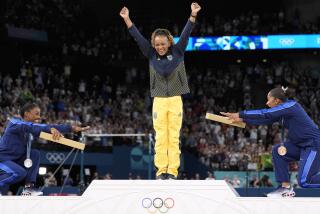WORLD SPORTS SCENE / RANDY HARVEY : Best of the World’s Best Came 25 Years Ago
- Share via
As enthusiasts of a sport that has a record book thicker than Webster’s Unabridged, track and field fans love to speak in the language of superlatives.
In many cases, they have the authority of precise measurements, either of time or distance, on their side. On other occasions, however, they become swept away in their own hyperbole. That was the best curve ever run, the best relay handoff, the best hammer-throw competition on a Thursday, etc., etc.
But, when virtually everyone who watched the 1968 Summer Olympics at Mexico City tells you that it was the best meet they have ever seen, it is not easy to argue with them. Possible, but not easy.
This discussion has an element of timeliness because it was 25 years ago today that two of the greatest--another superlative, this one unassailable--records in the sport’s history were set. On Oct. 18, 1968, Bob Beamon long jumped 29 feet 2 1/2 inches, and Lee Evans ran the 400 meters in 43.86 seconds.
Beamon’s jump remained in the record books until Mike Powell jumped 29-4 1/2 in 1991. Evans’ record lasted until Butch Reynolds ran 43.29 in 1988.
Less memorable, but even more impressive for longevity, was the time of 2:56.16 run by the U.S. 1,600-meter relay team of Vince Matthews, Ronald Freeman, Larry James and Evans. That record was equaled in 1988 but not broken until last year, when the U.S. team of Andrew Valmon, Quincy Watts, Michael Johnson and Steve Lewis ran 2:55.74 in the Barcelona Olympics.
Both 100-meter records also fell in Mexico City. Jim Hines ran 9.95, which remained as the world’s fastest for a mere 15 years before Calvin Smith ran 9.93 in 1983, and Wyomia Tyus ran 11.08.
All of those records have track and field’s equivalent of an asterisk beside them, an “a” for altitude. Mexico City is 7,500 feet above sea level, and, based on what we have learned since 1968, there is little question that the performances were enhanced by the thin air.
It was not only the world records, however, that made the meet special:
--One week after collapsing on the track with stomach pains in the 10,000 and three days after finishing fourth in the 5,000, Kenyan Kip Keino upset Jim Ryun to win the 1,500.
--Al Oerter became the only track and field athlete to win a gold medal in the same event in four consecutive Games with an Olympic discus-throw record of 212-6, five feet farther than he had ever thrown before.
--The “Fosbury Flop” was born when Dick Fosbury approached the bar headfirst but then turned his back to the pit, revolutionizing the high jump.
--Bob Seagren won the pole vault, something an American had done in each Olympics since 1896, but not once since.
--Randy Matson won the shotput, something an American had done in 13 of the previous 15 Olympics, but would not do again until 1992.
And, of course, there were the black-power victory-stand salutes by Tommie Smith and John Carlos after they finished first and third, respectively, in the 200 meters.
The picture of that protest lingers with us perhaps more than any other from Mexico City, punctuating a summer in which black athletes were torn between fulfilling personal goals by competing in the Olympics or calling attention to racial inequality in their country by boycotting. Among the athletes who chose the latter course was Lew Alcindor in basketball.
Smith and Carlos achieved both goals. They were banned from the athletes’ village afterward, without even receiving a hearing from the U.S. Olympic Committee or the International Olympic Committee, but they won the respect of most of their teammates, blacks and whites.
“There’s no question it was the best track and field meet I’ve ever been involved with,” Stan Wright, an assistant coach for the 1968 U.S. team, said the other day from Sacramento.
“The records were fantastic, altitude or no altitude, but there was more to it than that. The athletes came together as a team like I’ve never seen before, to prove, I think, that they could overcome the adversity of that summer.”
Lasting Impressions
Long-lasting track and field records set during the 1968 Summer Olympics at Mexico City:
100 METERS
* Set: Oct. 14. Jim Hines, 9.95.
* Broken: July 3, 1983. Calvin Smith, 9.93.
400 METERS
* Set: Oct. 18. Lee Evans, 43.86
* Broken: Aug. 17, 1988. Butch Reynolds. 43.29.
LONG JUMP
* Set: Oct. 18. Bob Beamon, 29-2 1/2
* Broken: Aug. 30, 1991. Mike Powell, 29-4 1/2
1,600-METER RELAY
* Set: Oct. 20. United States (Vince Matthews, Ronald Freeman, Larry James, Lee Evans), 2:56.16.
* Equaled: Oct. 1, 1988. United States (Danny Everett, Steve Lewis, Kevin Robinzine, Butch Reynolds).
* Broken: Aug. 30, 1992. United States (Andrew Valmon, Quincy Watts, Michael Johnson, Steve Lewis), 2:55.74.
More to Read
Go beyond the scoreboard
Get the latest on L.A.'s teams in the daily Sports Report newsletter.
You may occasionally receive promotional content from the Los Angeles Times.










